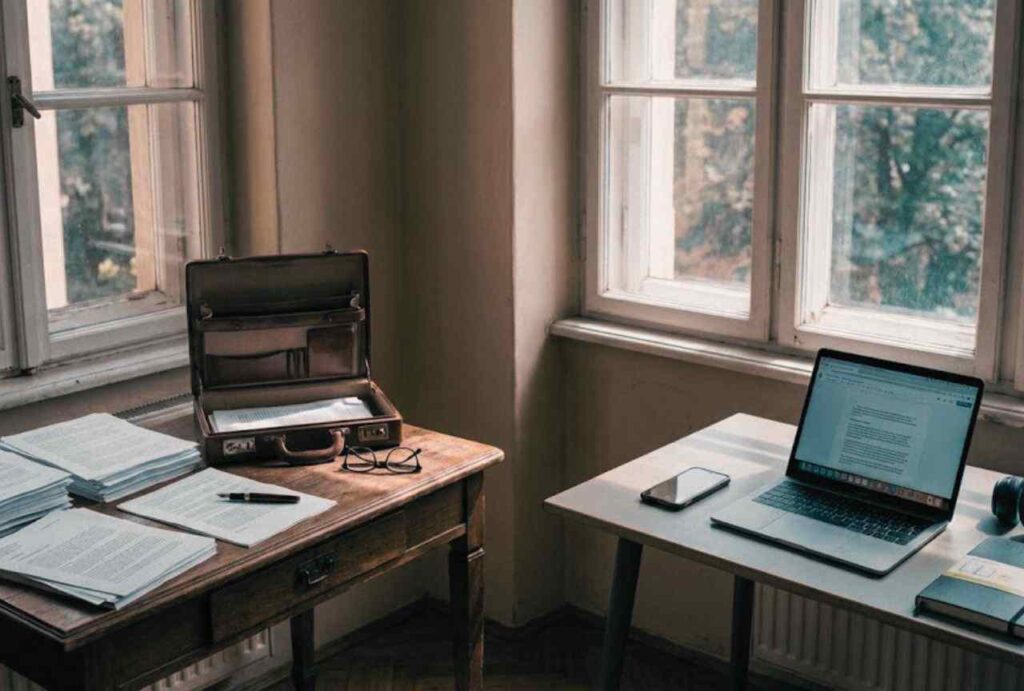You walk into a room, impeccably dressed, radiating confidence and professionalism. Your first impression is captivating and your style says a lot about you.
The visual language, unspoken yet potent, is a ticket to creating a memorable impact on your potential employers.
Your appearance during a job interview is more than just clothing; it’s a narrative you present about yourself, commitment to the role, and ultimately, your aspirations for professional success.
As you embark on the exhilarating quest for that dream job, it’s essential to make every interaction count, especially in the job interview.
So, buckle up as we explore how to dress for an interview as a man to not only complement your personal style but also align seamlessly with the expectations of the corporate world.
1. Knowing The Company’s Culture and Preferences:
Before you even think about what to wear for an interview, consider this: knowing the company’s culture is the compass guiding your clothes choices.
The first step in crafting an interview outfit that leaves an indelible mark is to delve into the essence of the organization you’re aiming to join.
1.1 Researching Company Culture: The Gateway to Smart Dressing
Scan the website, scrutinize social media profiles, and devour employee testimonials. This isn’t just about gathering information; it’s about immersing yourself in the company’s DNA.
Is it a tech startup fostering innovation with a casual vibe, or a law firm demanding a more traditional approach? Unearth the subtle cues that reveal the company’s personality.
1.2 Analyzing Employee Ensembles: Your Insider’s Guide
Ever heard the phrase “dress for the job you want, not the job you have”? While your current job might not require a suit and tie, the position you’re aspiring to might.
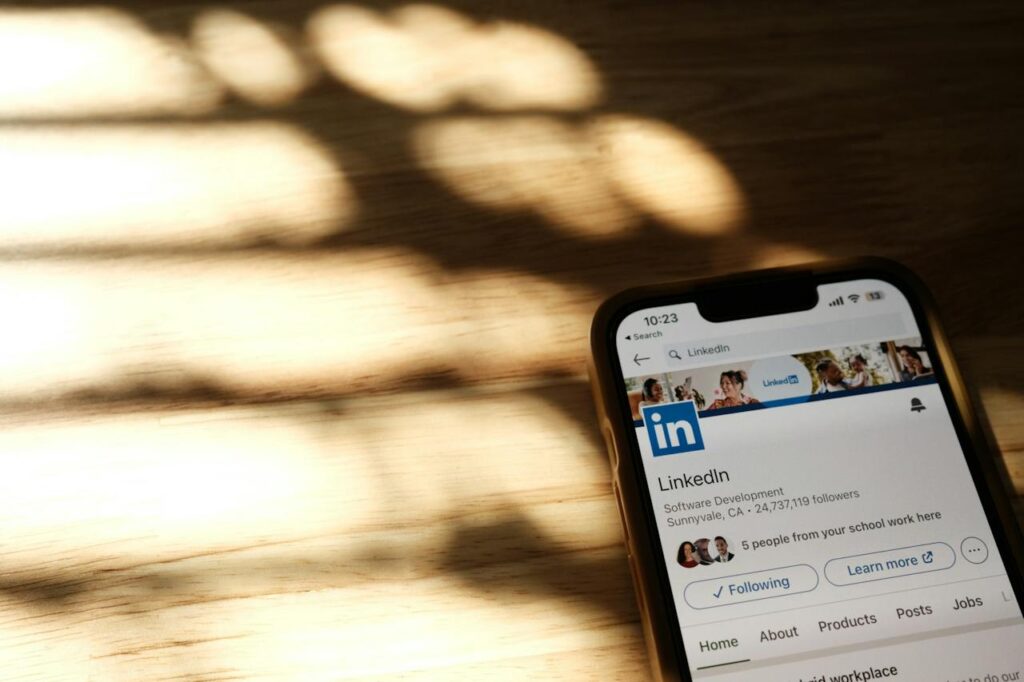
LinkedIn, the modern oracle of professional personas, can be your key to deciphering the unspoken dress code. Observe the attire of current employees in similar roles. Are they leaning towards sharp suits or opting for a business-casual charm? Take notes; this insider intel will be your styling compass.
1.3 Gauging Industry Standards: Elevating Your Dress Code IQ
Different industries dance to different sartorial tunes. While a creative agency might groove to the rhythm of individuality and flair, a financial institution might waltz with the classics.
Research not only the specific company but also the broader industry norms. Dressing appropriately is not just about fitting into a corporate puzzle but also signaling your understanding of professional norms within your chosen field.
1.4 Navigating Dress Codes: From Business Casual to Boardroom Chic
Now that you’ve gathered intelligence, it’s time to interpret it into your interview ensemble. Companies often have distinct dress codes, ranging from casual Fridays to formal boardroom attire.
Equip yourself with the knowledge of these codes, ensuring your outfit mirrors the company’s expectations. Remember, you’re not just dressing for the interview; you’re dressing to belong.
Also Read: 10 Proven Ways to Showcase Your Leadership Skills
2. How to dress for an interview as a Gentleman:
Now that you’ve decoded the company’s dress code, it’s time to choose what to wear for the interview that seamlessly blends professionalism with personal style.
Each element of your attire should exude confidence, competence, and a keen understanding of the corporate aesthetic.
2.1 The Power of a Crisp Dress Shirt:
In the realm of professional attire, the dress shirt stands tall as the epitome of elegance. Your choice of shirt can make a powerful statement about your attention to detail and personal style.
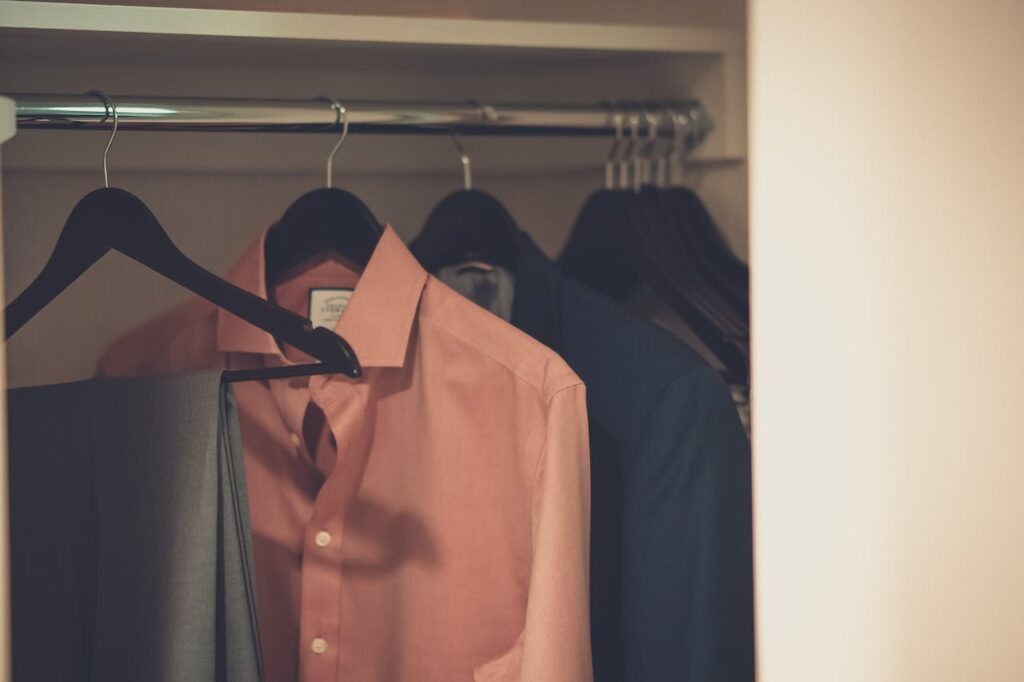
How to choose the Right Crisp Dress Shirt:
A. Color Palette: Begin with a foundation of crisp, white shirts. White exudes a timeless sophistication that aligns seamlessly with professional settings. If the workplace embraces a more relaxed dress code, you can introduce light blues or subtle patterns. However, for interviews, especially in conservative industries, white remains the safest and most powerful choice.
B. Fabric Matters: Opt for shirts crafted from high-quality, breathable fabrics like cotton or a cotton-blend. A breathable fabric ensures you stay comfortable throughout the interview, even under the pressure of high-stakes conversations.
C. Fit is Paramount: The fit of your shirt is non-negotiable. A well-fitted shirt compliments your physique and exudes professionalism. Ensure the shirt is neither too tight nor too loose, with sleeves reaching just past your wrist bone when your arms are at your sides.
D. Collar Style: Choose a collar style that complements the shape of your face. Spread collars are versatile and work well for most face shapes. Avoid extremes, such as overly wide or narrow collars, for a balanced look.
How to wear the Dress Shirt:
A. Tucked In, Always: Unless you’re wearing a casual shirt for a specific dress code, your dress shirt should always be tucked in. This simple act transforms your look from casual to polished instantly.
B. Buttoning Correctly: For a formal setting, always button your shirt to the top, leaving no more than one button undone. If you’re opting for a tie, ensure the top button is securely fastened.
C.Sleeve Length: The sleeves of your dress shirt should end just past your wrist bone when your arms are at your sides. This ensures a neat appearance and allows for a subtle display of your wrist accessories, such as a watch or cufflinks.
D. Ironed to Perfection: Wrinkles are the enemy of a polished look. Iron your shirt meticulously to eliminate any creases. Pay special attention to the collar and cuffs, as these are focal points.
E. The Ties That Bind: If you’re wearing a tie, ensure it complements the color and pattern of your shirt. The tie’s tip should ideally touch the top of your belt.
Here are our top recommendation for an affordable Crisp Dress Shirt:
1 – Calvin Klein Men’s Dress Shirt Regular Fit Non Iron Herringbone
2 – Kenneth Cole Men’s Dress Shirt Regular Fit Solid
By adhering to these guidelines, you’ll transform the dress shirt from a mere garment into a symbol of your professionalism and commitment to sartorial excellence.
The dress shirt, when chosen and worn correctly, becomes your silent ally in making a lasting impression during interviews and beyond.
2.2 Choosing Trousers for job interview:
When it comes to choosing pants for a job interview, the spotlight turns to tailored perfection. Your choice in pants holds the key to presenting a polished and professional image.
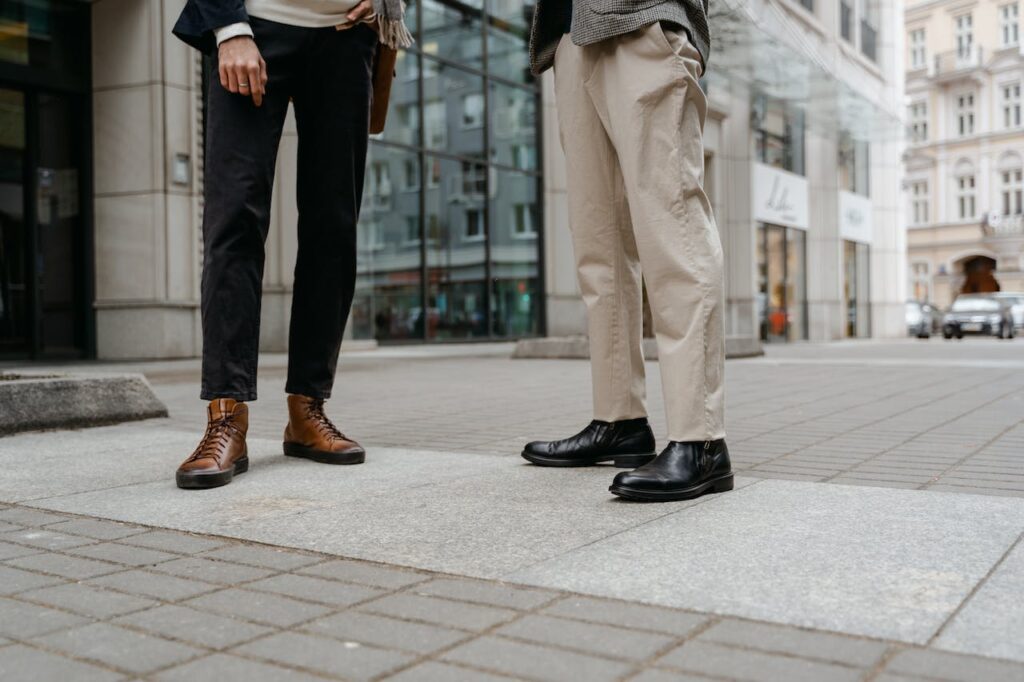
Choosing the Right Trousers:
A. Color Harmony: Stick to classic, versatile colors such as navy, charcoal gray, or subtle shades of black. These colors seamlessly pair with a variety of shirt and shoe options while exuding a sense of sophistication.
B. Fit Defines Fashion: The fit of your trousers plays a pivotal role in defining your overall look. Aim for a tailored fit that isn’t too tight or too loose. The trousers should sit comfortably at your waist without the need for a belt to keep them in place.
C. Pleats or Flat Front: For a modern and streamlined appearance, choose flat-front trousers. However, if you prefer a more traditional look and added room around the hips, pleated trousers can be a viable choice.
Wearing Tailored Trousers Properly:
A. The Ideal Length: The hem of your trousers should lightly graze the top of your shoes when standing. This subtle break creates a clean line and ensures your shoes are visible without being overly exposed.
B. Belted Sophistication: If your trousers feature belt loops, a classic leather belt in a color that compliments your shoes is a must. Ensure the belt is in good condition, and the buckle is understated.
C. Avoid Cargo or Denim: Regardless of the company’s dress code, job interviews call for a level of formality that cargo pants or denim cannot provide. Stick to tailored, dressy trousers for a look that exudes professionalism.
D. Well-Pressed Presentation: Like your dress shirt, your trousers should be free of wrinkles. Ensure a crisp appearance by ironing or steaming your trousers before the interview.
E. Sock Harmony: When sitting down, your socks might make a brief appearance. Choose socks that match the color of your trousers or shoes to maintain a cohesive and polished look.
Here are our top recommendation for an affordable trousers:
1 – Van Heusen Men’s Slim Fit Flex Super Soft Tech Pant
2 – Haggar Men’s The Active Series Slim Fit Pant
3 – Calvin Klein Men’s Modern Fit Dress Pant
2.3 How to properly pick and wear a Blazer:
A well-fitted blazer elevates your look instantly. It’s a quintessential element in any male wardrobe, especially when preparing for a job interview.
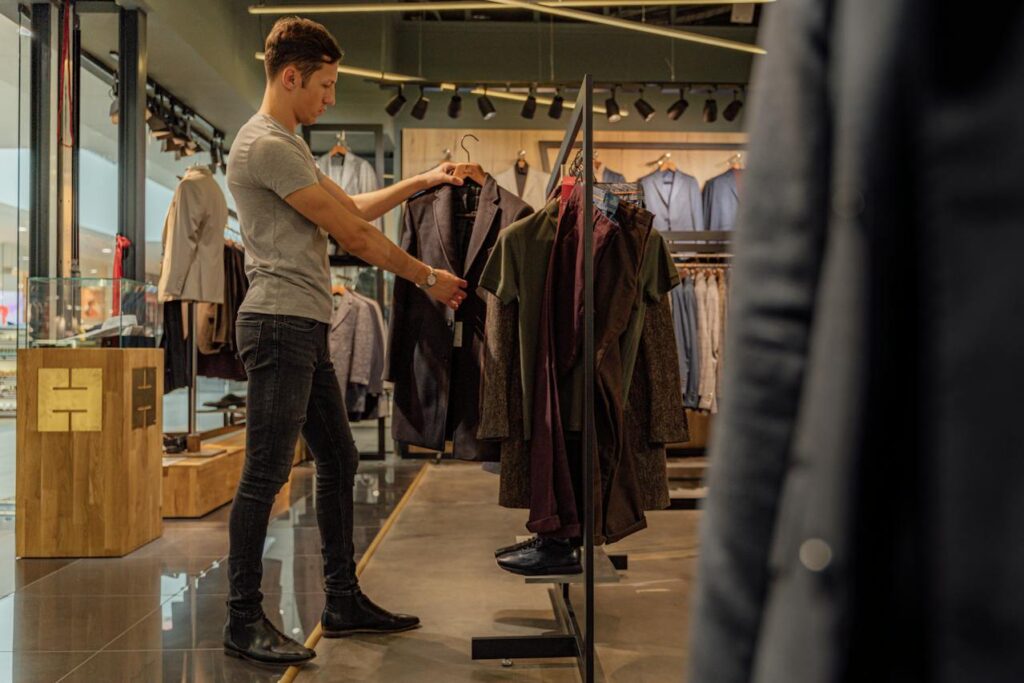
Here are some best practices for choosing and wearing blazers:
A. Single-Breasted vs. Double-Breasted: For most job interviews, a single-breasted blazer is the go-to choice. It’s versatile, timeless, and works well in professional settings. Double-breasted blazers, while stylish, may be more suitable for creative or less formal industries.
B. Fit is Paramount: A well-fitted blazer enhances your silhouette and exudes a polished look. Ensure the shoulders align correctly, the jacket isn’t too tight or loose, and the sleeves reveal just a hint of your dress shirt cuffs.
C. Buttoning Etiquette: If your blazer is single-breasted, button the top button when standing and unbutton it when sitting. For a double-breasted blazer, keep the bottom button fastened.
D. Pocket Square Elegance: Consider adding a subtle pocket square for a touch of personality. Ensure it compliments your shirt but doesn’t overpower the overall ensemble.
E. Versatile Pairing: A well-chosen blazer effortlessly elevates your overall look. It pairs seamlessly with dress shirts and tailored trousers, instantly transforming a simple ensemble into a sophisticated outfit suitable for any job interview.
Here are some stylish, fitting, and affordable blazer recommendations:
1 – COOFANDY Men’s Casual Blazer Jacket Slim Fit
2.4 Choosing the right shoes for job interview:
Your choice of footwear should complete the ensemble. it should seamlessly blend with your outfit.
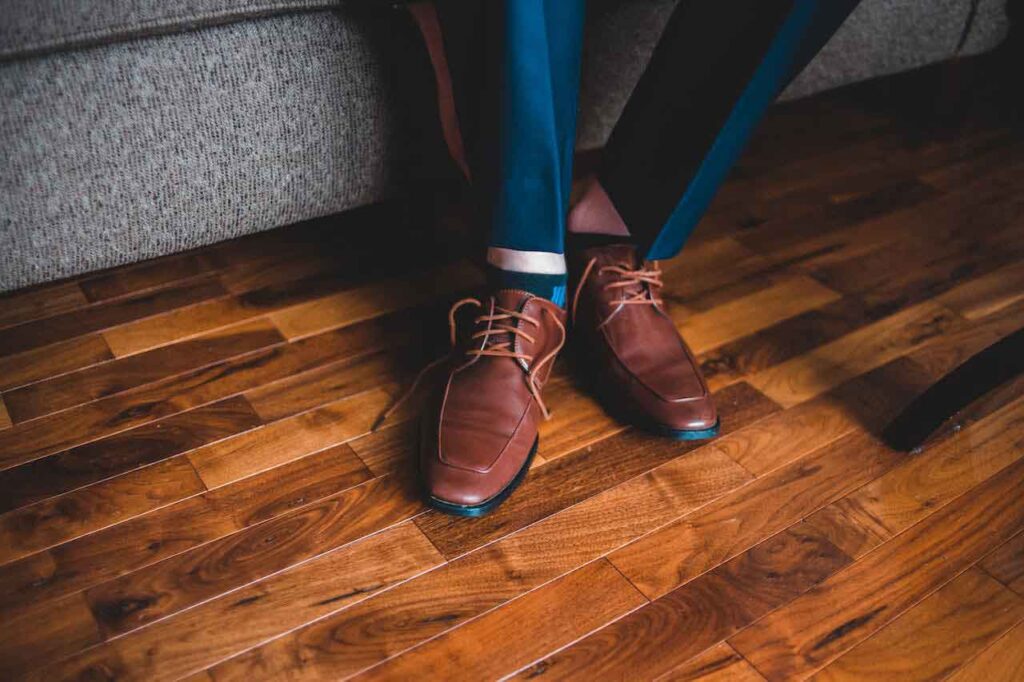
Guidelines for Choosing Interview Shoes:
A. Classic Elegance: Opt for classic styles such as oxfords or derbies. These timeless choices exude sophistication and are universally accepted in professional settings.
B. Color Coordination: Match the color of your shoes with your belt for a polished look. Stick to classic shades like black, brown, or dark tan. Ensure the hue complements your overall attire.
C. Well-Maintained Condition: Regardless of the style you choose, ensure your shoes are well-maintained and polished. Scuffed or worn-out shoes can detract from an otherwise impeccable ensemble.
D. Comfort is Key: Job interviews can be nerve-wracking, and the last thing you need is uncomfortable footwear. Choose shoes that not only look good but also provide the comfort needed for a day of professional interactions.
Here are some stylish, classic, and affordable shoes recommendations:
1 – Clarks Men’s Tilden Cap Oxford
2 – Cole Haan Men’s Grand Series Jensen Sneaker
3 – STACY ADAMS Men’s Dickinson Cap-Toe Lace-up Oxford
4- Cole Haan Men’s Original grand Energy Meridian Shortwing Oxford
2.5 To Tie or Not to Tie for a job interview?
The choice of whether or not to wear a necktie to a job interview often sparks a sartorial debate.
While a necktie can add a touch of formality and polish to your ensemble, its necessity varies based on industry norms, the specific role you’re applying for, and the individuals you’ll be meeting.
Factors to Consider:
A. Industry Standards: In more traditional and formal industries such as finance, law, or corporate settings, wearing a necktie is often expected and can be viewed as a sign of respect for the professional environment.
B. Company Culture: Researching the company culture is crucial. Start-ups or creative industries might adopt a more relaxed dress code where a necktie may be unnecessary. In contrast, established corporate environments may still adhere to traditional expectations.
C. Subtle Patterns: If you decide to wear a tie, opt for subtle patterns or solid colors. Avoid overly bold or flashy designs that could distract from your overall presentation.
In essence, the decision to wear a necktie boils down to a thoughtful consideration of the industry, company culture, and the expectations of the role you’re aiming for.
While a tie can undoubtedly elevate your look, sometimes the absence of one can signal adaptability and a keen understanding of the context.
So, to tie or not to tie? Let the nuances of your target workplace guide your decision.
Also Read: Strategic Job Research To Landing High-Paying Jobs
3. Grooming for a job interview:
Crafting a Polished Image
In professional interviews, your grooming routine can be just as impactful as your choice of outfit. The goal is to present a well-groomed and put-together appearance that complements your professional demeanor.
Here’s a concise guide to grooming essentials that can enhance your overall presence:
3.1 The best Haircut for job interview:
Men’s hairstyles should strike a balance between neatness and contemporary style. Tailor your hairstyle to align with the company culture and industry norms.
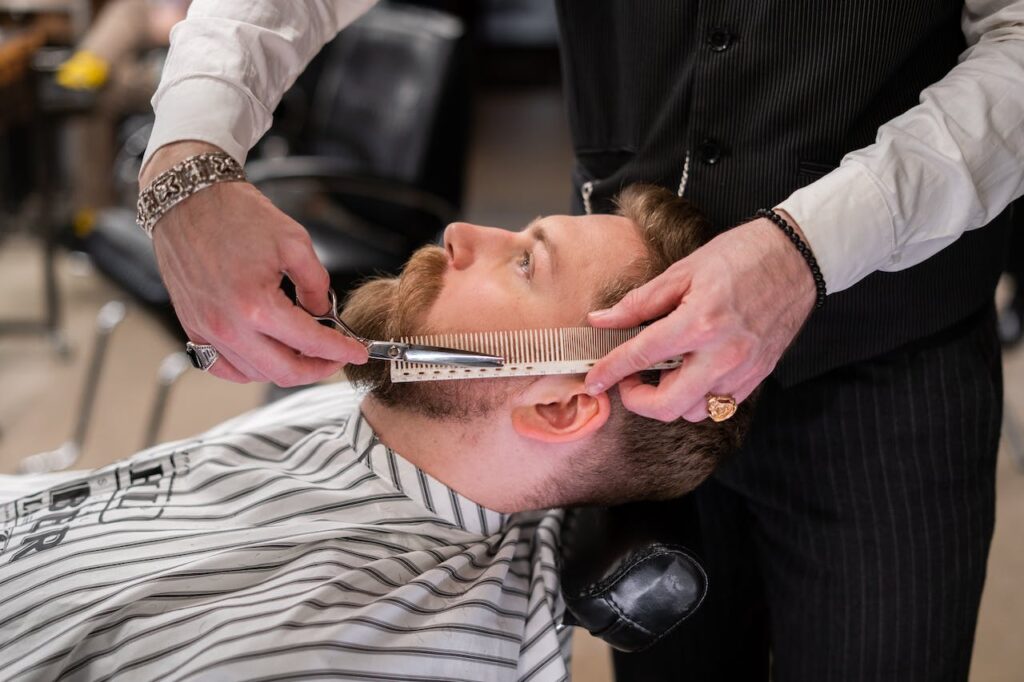
Regular Haircuts: Keep your hair neatly trimmed with regular haircuts. This not only enhances your appearance but also communicates a commitment to professionalism.
Hairstyling Products: If you use hair styling products, opt for minimal and subtle applications. A touch of pomade or wax can add a polished finish without being overly conspicuous.
3.2 Facial Hair Maintenance:
For those with facial hair, maintaining a well-groomed beard or mustache is key to presenting a polished image.
Trim and Shape: Regularly trim and shape your facial hair to maintain a tidy and professional look. Pay attention to areas around the neck and cheekbones.
Beard Oil or Balm: Use beard oil or balm to keep your facial hair soft and manageable. This adds a touch of sophistication and signals attention to detail.
3.3 Skin Care:
Investing time in a basic skincare routine can contribute to a healthy and vibrant complexion.
Cleansing Routine: Establish a daily skincare routine that includes cleansing. Clear, healthy skin can enhance your overall appearance and boost confidence.
Moisturize: Moisturizing is crucial to maintaining skin hydration. Opt for a non-greasy moisturizer to keep your skin looking fresh.
3.4 How to choose Fragrance for job interview:
Subtle fragrance can leave a lasting impression, but moderation is key. Remember this is not a party, it’s a job interview.
Light Application: Apply a light, neutral fragrance. Avoid overpowering scents, as strong fragrances can be distracting and may not be well-received in a professional setting.
3.5 Nails:
Well-maintained nails may seem like a small detail, but they contribute to an overall polished look.
Clean and Trimmed: Ensure your nails are clean and trimmed. This attention to detail reflects positively on your commitment to personal hygiene.
4. Mastering the art of confidence in a job interview:
Projecting confidence during a job interview is as crucial as choosing the right outfit. Confidence not only influences how others perceive you but also shapes your own mindset.
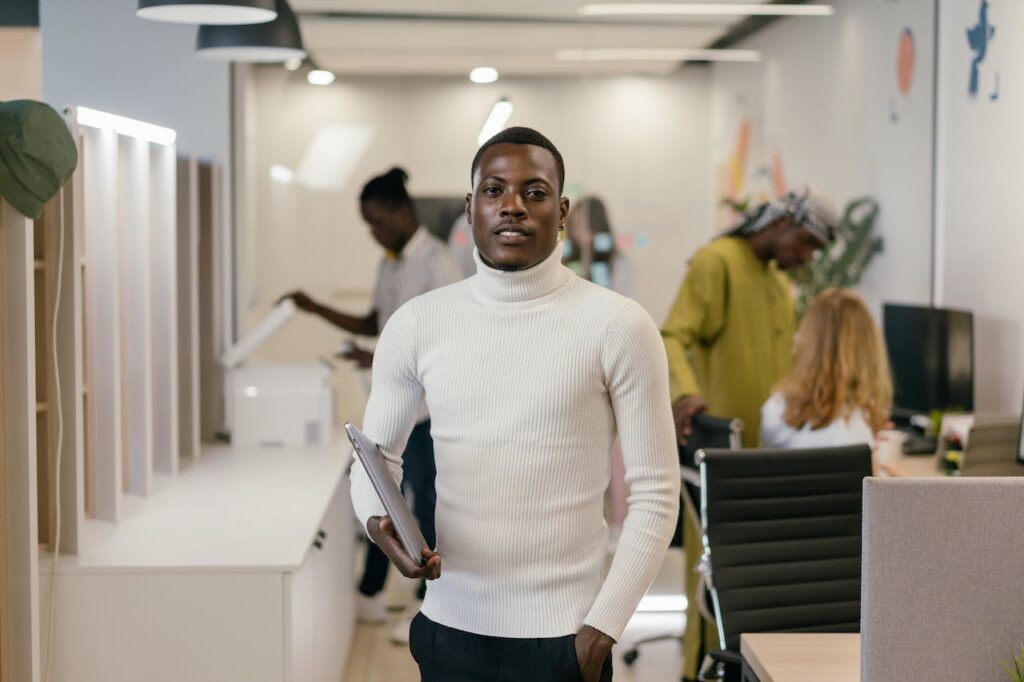
Elevate your confidence with these strategies:
Project Strong Body Language: Maintain eye contact for engagement and offer a firm handshake for professionalism. Stand tall and sit with poise to convey confidence.
Speak Clearly and Thoughtfully: Articulate your thoughts clearly and at a measured pace. Practice vocal modulation to maintain interest.
Harness Positive Self-Talk: Replace self-doubt with positive affirmations. Visualize success and focus on your achievements to boost confidence.
Thorough Preparation: Know your resume in detail, and research the company to demonstrate genuine interest and bolster your confidence.
Embrace Authenticity: Be yourself and acknowledge imperfections. Authenticity fosters genuine connections and leaves a lasting positive impression.
Confidence is a continuous journey, and integrating these strategies into your interview preparation will help you showcase your capabilities with poise and assurance.
Summary: A Distinguished Impression Through Attire
As you step into the realm of job interviews, remember that your style is a powerful tool in shaping the first impression.
Crafting a distinguished and polished look involves thoughtful consideration of each element, from crisp dress shirts to well-chosen accessories.

Investing time in understanding the company culture, choosing the right clothes, and presenting yourself with confidence can significantly impact your interview experience.
It’s not just about adhering to a dress code, it’s about aligning your appearance with the professional image you wish to project.
By embracing the guidance provided in this comprehensive guide, you’ll navigate the complexities of dressing for success with ease.
Your style should not only reflect your competence but also highlight your understanding of the company’s values and expectations.



